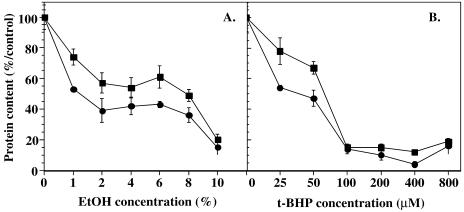Fig 4.
Role of retrovirally transfected apolipoprotein J (apo J) against cytotoxic stresses with ethanol (EtOH) and tert-butylhydroperoxide (t-BHP) in WI-38 human diploid fibroblasts (HDFs). (A) Survival curves of WI-38 HDFs exposed to increasing concentrations of EtOH. Cells were subcultivated in multiwell dishes at a density of 25 000 cells/cm2 and exposed, on the next day, to a stress of 2 hours with 0–10 % EtOH, diluted in phosphate-buffered saline (PBS). Cells were transfected with the PLXSN/apo J vector (▪) or the PLXSN control vector (•). Survival was determined at 24 hours after the stress. Results are expressed as percentages of the protein content of control cells (no EtOH), considered as 100 %, and are mean values of 4 independent experiments ± SD. (B) Survival curves of WI-38 HDFs exposed to increasing concentrations of t-BHP. Cells were subcultivated in multiwell dishes at a density of 25 000 cells/cm2 and exposed, on the next day, to a stress of 2 hours under 0–0.8 mM t-BHP, diluted in PBS. Cells were transfected with the PLXSN/apo J vector (▪) or the PLXSN control vector (•). Survival was determined at 24 hours after the stress. Results are expressed as percentages of the protein content of control cells (without EtOH), considered as 100 %, and are mean values of 4 independent experiments ± SD

